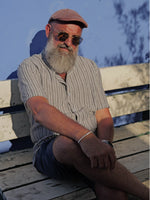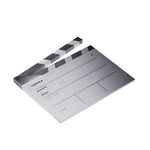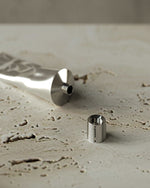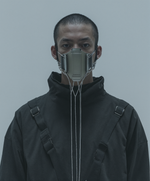20.09.23 in ambassadeurs
charles zana


A graduate of the Paris School of Fine Arts, Charles Zana is a French DPLG architect, but also a designer and scenographer, who came to interior architecture through a series of decisive encounters. he founded his own agency in 1990 and designs exceptional places (hotels, restaurants, homes, show rooms, etc.) all over the world, from Paris to London, including New York, Tel Aviv and Monaco.
how did you come to this profession and what are your sources of inspiration?
they are multiple in reality. but the first is, and will always remain, my studies in fine arts. I often say that I entered fine arts without really knowing the precise profession I was going to study or practice. Being an architect for me was a very vague concept. I was strong in scientific subjects and I had a real desire to work around art... as at that time these career paths did not exist, we naturally said to ourselves, my parents and I, that there were two parts to architecture: art and technique. and then, I like to tell this anecdote by saying that I chose to study there because from home, it was a direct bus ride…
it was fantastic, six years of discovery of architecture, art history, construction and then, we were mixed with the fine arts students. it was in the eighties with information coming from everywhere, we were really at the heart of a lot of things. years of youth, as Mitterrand would say, where I read a lot, studied and was enormously nourished by the architectural movements and art of the twentieth century, literature, music.
at that time, in this area, a new genre of galleries was starting to come out. they worked on the theme of the thirties, especially French, and this will always remain the movement that impressed me the most overall. I believe a lot in the movement of art in the global sense, when it touches on music, painting, literature, themes corresponding to a period of great changes. I believe more in revolutions than in developments, so the thirties during my period of study were really my reference, with the two French movements like the UAM (union of modern artists) and the decorative arts, the one in Germany, the Bauhaus, those of the Nordic countries, the Drakstil. without forgetting art and craft in England... all this excitement of a changing world, which was getting rid of an aesthetic shackles, and at times heavy with functionalism, to open up to new worlds.
Is this what still nourishes you today on a daily basis?
this gives me another look at creation, I always need to contextualize things, with substance behind the form. I have this need that art, artists, artistic movements, also correspond to an attitude, to a desire for the evolution of society, for change, for the creation of meaning.
once I finished my studies, I started going to the Milan salon and there I was influenced by Italian designers and by the four great Italian designers of that time. in the nineties they were called sottsass, branzi, de lucchi and mendini. Italian design interested me and seduced me precisely by its way of shaking up the border between architecture and design in order to bring design towards a societal reflection, environmental for branzi, decorative for mendini, spiritual for sottsass and aesthetic for lucchi. it changed a little the order of things and of the design that I had enjoyed studying and which always talked about function. whereas there, it was a group of architects very strong on reflection and on a whole form of introspection… sottsass has always highlighted his own moods in his design, we can read his life through his work. getting rid of protocol is in fact the principle of the architect... which is much closer to the artistic world; and these are my great passions in architecture.
how did you come to this profession and what are your sources of inspiration?
they are multiple in reality. but the first is, and will always remain, my studies in fine arts. I often say that I entered fine arts without really knowing the precise profession I was going to study or practice. Being an architect for me was a very vague concept. I was strong in scientific subjects and I had a real desire to work around art... as at that time these career paths did not exist, we naturally said to ourselves, my parents and I, that there were two parts to architecture: art and technique. and then, I like to tell this anecdote by saying that I chose to study there because from home, it was a direct bus ride…
it was fantastic, six years of discovery of architecture, art history, construction and then, we were mixed with the fine arts students. it was in the eighties with information coming from everywhere, we were really at the heart of a lot of things. years of youth, as Mitterrand would say, where I read a lot, studied and was enormously nourished by the architectural movements and art of the twentieth century, literature, music.
at that time, in this area, a new genre of galleries was starting to come out. they worked on the theme of the thirties, especially French, and this will always remain the movement that impressed me the most overall. I believe a lot in the movement of art in the global sense, when it touches on music, painting, literature, themes corresponding to a period of great changes. I believe more in revolutions than in developments, so the thirties during my period of study were really my reference, with the two French movements like the UAM (union of modern artists) and the decorative arts, the one in Germany, the Bauhaus, those of the Nordic countries, the Drakstil. without forgetting art and craft in England... all this excitement of a changing world, which was getting rid of an aesthetic shackles, and at times heavy with functionalism, to open up to new worlds.
Is this what still nourishes you today on a daily basis?
this gives me another look at creation, I always need to contextualize things, with substance behind the form. I have this need that art, artists, artistic movements, also correspond to an attitude, to a desire for the evolution of society, for change, for the creation of meaning.
once I finished my studies, I started going to the Milan salon and there I was influenced by Italian designers and by the four great Italian designers of that time. in the nineties they were called sottsass, branzi, de lucchi and mendini. Italian design interested me and seduced me precisely by its way of shaking up the border between architecture and design in order to bring design towards a societal reflection, environmental for branzi, decorative for mendini, spiritual for sottsass and aesthetic for lucchi. it changed a little the order of things and of the design that I had enjoyed studying and which always talked about function. whereas there, it was a group of architects very strong on reflection and on a whole form of introspection… sottsass has always highlighted his own moods in his design, we can read his life through his work. getting rid of protocol is in fact the principle of the architect... which is much closer to the artistic world; and these are my great passions in architecture.
“I believe in the movement of art in the global sense, when it touches on music, painting, literature, themes corresponding to a period of great change. »


Who are the people or projects that, according to you, constitute references?
as a French architect or decorator, the one who immediately comes to mind is Jean-Michel Frank, because indeed, I like his way of always being anchored in tradition, in the material and in a expertise. he is someone who has been very discreet about his work. he built a real team around him, notably with Giacometti.
for Italy, I think that it is Carlo Scarpa who is for me the greatest Italian architect of the twentieth century. otherwise, as an artist I would say Picasso, but that's not very original.
What would you like people to say about you years from now?
we released a furniture collection six months ago that we called: ithaque. it is the city from which Homer left and then returned. I came to architecture through furniture, so I think that leaving iconic furniture, letting certain very simple shapes really become references of our time, that's what I would like to be able to leave as an image of my projects.
What compliment means the most to you about your work as an interior designer?
When I started, I used to say that I liked architecture where you don't feel the architect, where everything becomes somewhat formal, where circulation takes place very freely. the best compliment actually is to recognize the work we have done at the office, to recognize ourselves through our projects but with time, that it infuses a little, that the look after a while says finally: I have the impression of recognizing something, of not working on the obvious but rather on a form of humility and withdrawal from the project.
favorite themes in your creative approach?
I always start from the plan, because as an architect, like Italian designers elsewhere, we always compose a plan. we start from three things, whether on house projects, for a foundation or a brand. firstly the context where we create, the city, the place, the light... secondly it is the history of the family or of a brand. and thirdly, of a form, of the era of time, of desire, because we change with the years. we want to change and bring in slightly new things and so we always start from these three things.
as a French architect or decorator, the one who immediately comes to mind is Jean-Michel Frank, because indeed, I like his way of always being anchored in tradition, in the material and in a expertise. he is someone who has been very discreet about his work. he built a real team around him, notably with Giacometti.
for Italy, I think that it is Carlo Scarpa who is for me the greatest Italian architect of the twentieth century. otherwise, as an artist I would say Picasso, but that's not very original.
What would you like people to say about you years from now?
we released a furniture collection six months ago that we called: ithaque. it is the city from which Homer left and then returned. I came to architecture through furniture, so I think that leaving iconic furniture, letting certain very simple shapes really become references of our time, that's what I would like to be able to leave as an image of my projects.
What compliment means the most to you about your work as an interior designer?
When I started, I used to say that I liked architecture where you don't feel the architect, where everything becomes somewhat formal, where circulation takes place very freely. the best compliment actually is to recognize the work we have done at the office, to recognize ourselves through our projects but with time, that it infuses a little, that the look after a while says finally: I have the impression of recognizing something, of not working on the obvious but rather on a form of humility and withdrawal from the project.
favorite themes in your creative approach?
I always start from the plan, because as an architect, like Italian designers elsewhere, we always compose a plan. we start from three things, whether on house projects, for a foundation or a brand. firstly the context where we create, the city, the place, the light... secondly it is the history of the family or of a brand. and thirdly, of a form, of the era of time, of desire, because we change with the years. we want to change and bring in slightly new things and so we always start from these three things.
“what really appealed to me about your bracelets were the matte, shiny effects; This made me really want to rework the silvers and silvering. »


what are your favorite materials, shapes or patterns?
there are certain materials like travertine that we have worked on a lot because, for me, it is a stone that is very noble and also where we see the passage of time. hollowed wood, always, because it's a bit the same thing, it reveals the material, the raw tones. and it's funny because that's precisely what made me really want your bracelets, all the matte, shiny effects; This made me really want to rework silver and silver plating, which is a bit complicated in furniture, because silver passes but I find that seeing the sign of time on furniture is always very interesting.
your biggest challenge achieved or to be achieved?
I am always fascinated and interested in new projects. as soon as we are consulted on a new project we are always excited at the agency. we're lucky enough to be able to work almost everywhere and not repeat things, so it's always a bit of a novelty. At the moment, we are being consulted on a house in Stockholm; it is located in a completely art and craft district, just like in a garden city from the 1900s. all of a sudden, I say to myself that Stockholm makes me dream, I am always in the idea that the next project will be the more interesting.
If you weren't an interior designer, what job would you do?
it's difficult... because I've known since I was 10-12 years old that I wanted to be in this field since, indeed, I had gotten into the idea that it was a way of studying art. looking back today, I only discovered this profession now, over the last ten years; I find that artistic direction is something that I did not understand when I was young, it is more and more important in the world in which we live. I think that the more images that are broadcast, the more words that are written everywhere, and the more we will need strong artistic direction. It's not really far from what I do, of course, but a pure artistic direction to work on a brand, on a meaning, ultimately without creating, but by telling ourselves that we manage to interfere and move things.
What is the city that inspires you or resembles you?
I really like Venice, I have worked there and done exhibitions, I think this city resembles me perhaps because it is not in the best place; I'm always a little fascinated by sites and wonder why the big cities or historically important towns are there. why is jerusalem in this place? so jerusalem, there is an explanation, because it is the point which is the highest when you go up from the sea before going down into the desert, so there is a real important position. Venice is undoubtedly a city that resembles me with its rather fantastic palaces. what I also like a lot is its city of merchants side, so I like this feeling that it was built by people who did trade, and the slightly crazy side of this city where the we don't move around like everywhere.
there are certain materials like travertine that we have worked on a lot because, for me, it is a stone that is very noble and also where we see the passage of time. hollowed wood, always, because it's a bit the same thing, it reveals the material, the raw tones. and it's funny because that's precisely what made me really want your bracelets, all the matte, shiny effects; This made me really want to rework silver and silver plating, which is a bit complicated in furniture, because silver passes but I find that seeing the sign of time on furniture is always very interesting.
your biggest challenge achieved or to be achieved?
I am always fascinated and interested in new projects. as soon as we are consulted on a new project we are always excited at the agency. we're lucky enough to be able to work almost everywhere and not repeat things, so it's always a bit of a novelty. At the moment, we are being consulted on a house in Stockholm; it is located in a completely art and craft district, just like in a garden city from the 1900s. all of a sudden, I say to myself that Stockholm makes me dream, I am always in the idea that the next project will be the more interesting.
If you weren't an interior designer, what job would you do?
it's difficult... because I've known since I was 10-12 years old that I wanted to be in this field since, indeed, I had gotten into the idea that it was a way of studying art. looking back today, I only discovered this profession now, over the last ten years; I find that artistic direction is something that I did not understand when I was young, it is more and more important in the world in which we live. I think that the more images that are broadcast, the more words that are written everywhere, and the more we will need strong artistic direction. It's not really far from what I do, of course, but a pure artistic direction to work on a brand, on a meaning, ultimately without creating, but by telling ourselves that we manage to interfere and move things.
What is the city that inspires you or resembles you?
I really like Venice, I have worked there and done exhibitions, I think this city resembles me perhaps because it is not in the best place; I'm always a little fascinated by sites and wonder why the big cities or historically important towns are there. why is jerusalem in this place? so jerusalem, there is an explanation, because it is the point which is the highest when you go up from the sea before going down into the desert, so there is a real important position. Venice is undoubtedly a city that resembles me with its rather fantastic palaces. what I also like a lot is its city of merchants side, so I like this feeling that it was built by people who did trade, and the slightly crazy side of this city where the we don't move around like everywhere.
“I am always fascinated and interested in new projects. as soon as we are consulted on a new project we are always excited at the agency. we are lucky to be able to work almost everywhere and not repeat things. »


what is important in your life?
lots of things: family, friendship, love, my team….
I think that what differentiates us from the great architects of a hundred years ago is that we have corporate constructions where there is less ego, but more the idea of bringing an office, and a whole team, to do something. Today, I have been a teacher for five years, that's nice, it's really something that has meaning for me, to go to school once a week to give lessons.
What is the gift you would like to receive soon?
a watch, and more particularly the cartier tank.
I know that now it's more the chronograph watches, the big watches, but I prefer the Cartier watch... I saw a photo of Serge Gainsbourg where he is wearing this watch and I say to myself that in fact it It's a great attitude.
It's always a bit of my story to think that there are very classic, very fine things and it's their quality that matters. that's a bit what I thought of the le gram bracelets, I have the impression that they refer to the bracelets that I had when I was seventeen or eighteen years old and we were a bit in this cool era; we all had a very simple silver bracelet and we even gave it value. I don't know if it was true, but at the time we thought these bracelets had value.
and what gift do you give to someone you love?
I like collecting women's jewelry and giving jewelry. I had seen a very beautiful exhibition on decorative arts jewelry and I found that it was quite incredible what we saw on artists' jewelry... because it was a shortcut to the history of art. I find it a very difficult exercise to bring them back to something very simple.
Finally, what do le gramme's creations inspire you?
I love this side of highlighting silver, and this time when we all had a bracelet to which we gave a value. In my opinion, this reference to the weight of things, the duration, the weight is very intelligent…
I like to mix my two le gram ribbon bracelets with my lighter fabric bracelets.
and if le gramme was a piece of furniture, what would it be?
it's very interesting because one of my favorite design objects is a chair called the superleggera. it was created by gio ponti and comes from a village called chiavari in italy. the people there specialized in creating very light chairs.
I wondered, during confinement, if we hadn't had a little enough of this era which ultimately complicated everything, made everything heavier... by creating weight with architects who spent a decade creating objects in marble, or very heavy metal. I think that lightening the mind goes with also lightening what we wear. For example, I find it more and more difficult to have heavy things, heavy suitcases or heavy school bags. so, when I saw your brand, I thought it was ultimately very intelligent to refer to weight, because we never think about it… and if you look at the trends, my children wear very light shoes. my son wears ultra-light jackets made from these new materials that are super light.
lots of things: family, friendship, love, my team….
I think that what differentiates us from the great architects of a hundred years ago is that we have corporate constructions where there is less ego, but more the idea of bringing an office, and a whole team, to do something. Today, I have been a teacher for five years, that's nice, it's really something that has meaning for me, to go to school once a week to give lessons.
What is the gift you would like to receive soon?
a watch, and more particularly the cartier tank.
I know that now it's more the chronograph watches, the big watches, but I prefer the Cartier watch... I saw a photo of Serge Gainsbourg where he is wearing this watch and I say to myself that in fact it It's a great attitude.
It's always a bit of my story to think that there are very classic, very fine things and it's their quality that matters. that's a bit what I thought of the le gram bracelets, I have the impression that they refer to the bracelets that I had when I was seventeen or eighteen years old and we were a bit in this cool era; we all had a very simple silver bracelet and we even gave it value. I don't know if it was true, but at the time we thought these bracelets had value.
and what gift do you give to someone you love?
I like collecting women's jewelry and giving jewelry. I had seen a very beautiful exhibition on decorative arts jewelry and I found that it was quite incredible what we saw on artists' jewelry... because it was a shortcut to the history of art. I find it a very difficult exercise to bring them back to something very simple.
Finally, what do le gramme's creations inspire you?
I love this side of highlighting silver, and this time when we all had a bracelet to which we gave a value. In my opinion, this reference to the weight of things, the duration, the weight is very intelligent…
I like to mix my two le gram ribbon bracelets with my lighter fabric bracelets.
and if le gramme was a piece of furniture, what would it be?
it's very interesting because one of my favorite design objects is a chair called the superleggera. it was created by gio ponti and comes from a village called chiavari in italy. the people there specialized in creating very light chairs.
I wondered, during confinement, if we hadn't had a little enough of this era which ultimately complicated everything, made everything heavier... by creating weight with architects who spent a decade creating objects in marble, or very heavy metal. I think that lightening the mind goes with also lightening what we wear. For example, I find it more and more difficult to have heavy things, heavy suitcases or heavy school bags. so, when I saw your brand, I thought it was ultimately very intelligent to refer to weight, because we never think about it… and if you look at the trends, my children wear very light shoes. my son wears ultra-light jackets made from these new materials that are super light.
“I like to mix my two le gramme ribbon bracelets with my lighter fabric bracelets. »
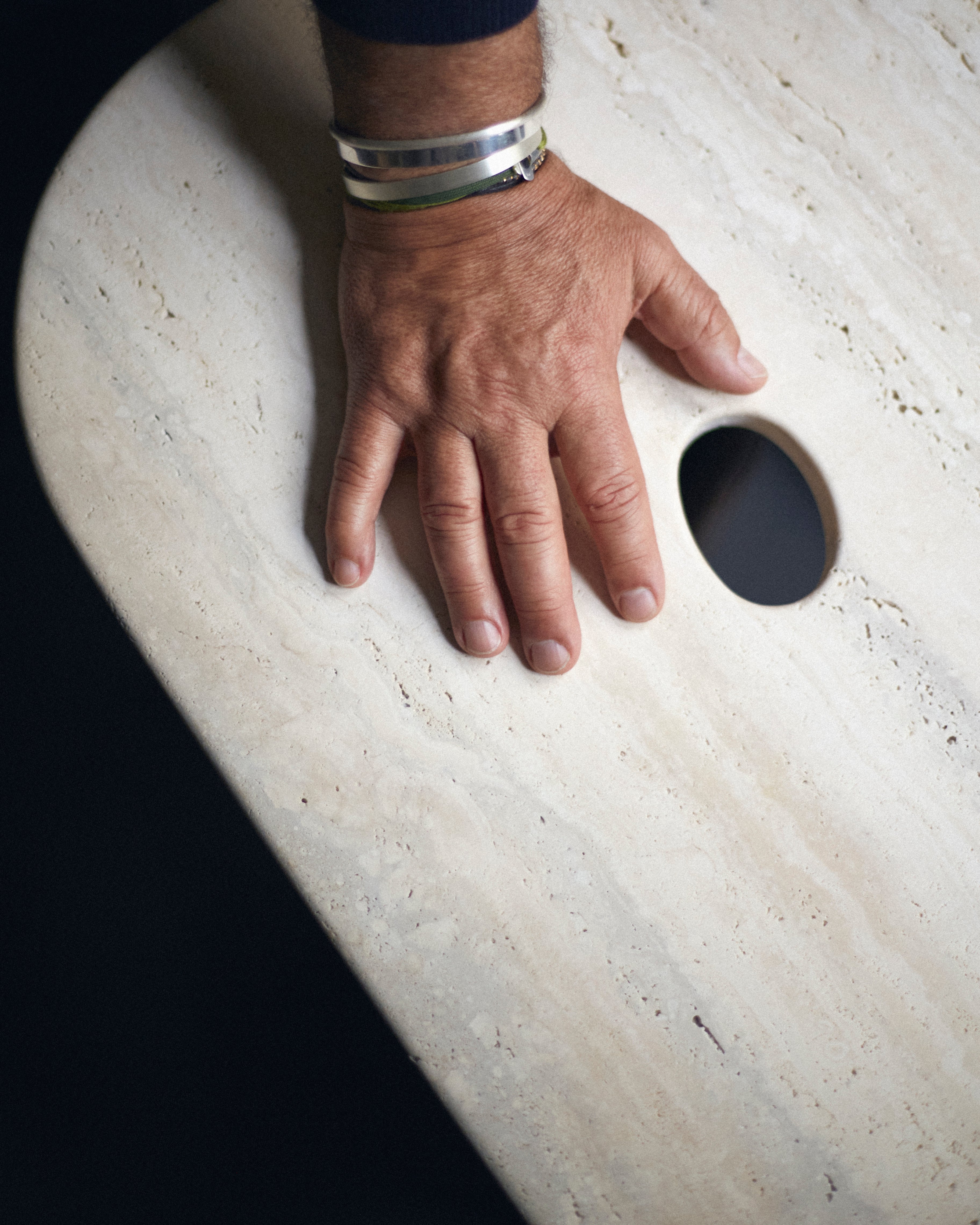
---accumulation---
bracelet_21g_black-silver-925_smooth_brush_ribbon;bracelet_15g_silver-925_smooth_brush_rush;bracelet_21g_silver-925_polished_smooth_ribbon
